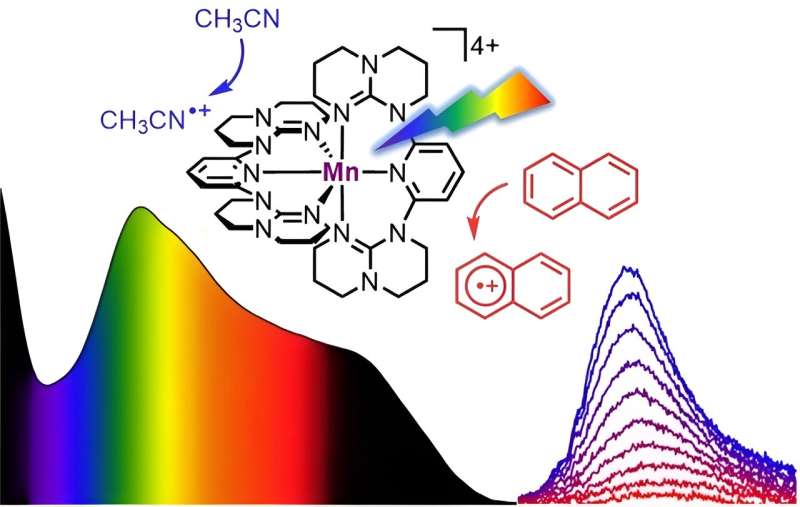This article has been reviewed according to Science X's editorial process and policies. Editors have highlighted the following attributes while ensuring the content's credibility:
fact-checked
trusted source
proofread
Scientists develop new molecular system made from abundant element manganese for photooxidation

Highly reducing or oxidizing photocatalysts are a fundamental challenge in photochemistry. Only a few transition metal complexes with Earth-abundant metal ions have so far advanced to excited state oxidants, including chromium, iron, and cobalt. All these photocatalysts require high energy light for excitation and their oxidizing power has not yet been fully exploited. Furthermore, precious and hence expensive metals are the decisive ingredients in most cases.
A team of researchers headed by Professor Katja Heinze of Johannes Gutenberg University Mainz (JGU) has now developed a new molecular system based on the element manganese. Manganese, as opposed to precious metals, is the third most abundant metal after iron and titanium and hence widely available and very cheap. The study is published in the journal Nature Chemistry.
Unusual behavior of 'molecular Braunstein'
The team of Professor Katja Heinze has designed a soluble manganese complex that absorbs all visible light from blue to red, i.e., in a wavelength of 400 to 700 nanometers, and parts of the near-infrared light up to 850 nanometers. This panchromatic absorption of the complex is reminiscent of the dark color of Braunstein or manganese dioxide, which is a natural mineral.
In contrast to the mineral Braunstein, the new "molecular Braunstein" emits NIR-II light with a wavelength of 1,435 nanometers after excitation with visible or NIR-I light with a wavelength of 850 nanometers. "This is an unusual observation for a molecular system based on manganese in its oxidation state +IV. Even with noble metals emission in this energy region is essentially unprecedented," said Professor Katja Heinze.
Even more intriguing beyond this NIR-II luminescence from a molecular manganese system is the observation that after photoexcitation the "molecular Braunstein" can oxidize various organic substrates. This includes extremely challenging aromatic molecules with very high oxidation potentials such as naphthalene, toluene, or benzene.
"Even otherwise very stable solvents can be attacked by the superphotooxidant when excited by LED light," said Dr. Nathan East, who prepared the new complex and performed all photolysis experiments during his Ph.D. in the group of Professor Katja Heinze.
Observation of two photoactive states thanks to ultrafast spectroscopy
Ultrafast spectroscopic techniques using laser pulses with sub-picosecond time resolution revealed an unusual excited-state reactivity and two different photoactive states: a very short-lived but extremely oxidizing high-energy state and a longer-lived moderately oxidizing lower-energy state. The former can attack solvent molecules that are already close to complex before the light excitation, while the latter excited state exists long enough to attack aromatic substrates after diffusional collision.
"This is called static and dynamic quenching of the excited states," explained Dr. Robert Naumann, a senior scientist specialized in time-resolved spectroscopy in the group of Professor Katja Heinze.
Quantum chemical calculations to understand unusual photoprocesses
"A detailed picture of the photoinduced processes emerged when we modeled the involved excited states by quantum chemical calculations in the light of the spectroscopic results," said Heinze.
"These advanced and time-consuming calculations were only possible using the computing power of the supercomputers MOGON and ELWETRITSCH in Rhineland-Palatinate," said Dr. Christoph Förster, a senior scientist in the group of Katja Heinze, who was strongly involved in the quantum chemical study.
In the future, scientists may be able to develop new challenging light-driven reactions using the common and abundant metal manganese. This will not only replace the rare, more costly ruthenium and iridium compounds, which today are still the most frequently used, but even enable reaction and substrate classes that are unavailable with the classical compounds.
"With our own newly installed ultrafast laser system, the computing power of high-performance supercomputers, and the creativity and skills of our Ph.D. students we will continue to push on with our efforts to develop a more sustainable photochemistry," said Professor Katja Heinze.
More information: Nathan R. East et al, Oxidative two-state photoreactivity of a manganese(IV) complex using near-infrared light, Nature Chemistry (2024). DOI: 10.1038/s41557-024-01446-8
Provided by Johannes Gutenberg University Mainz




















